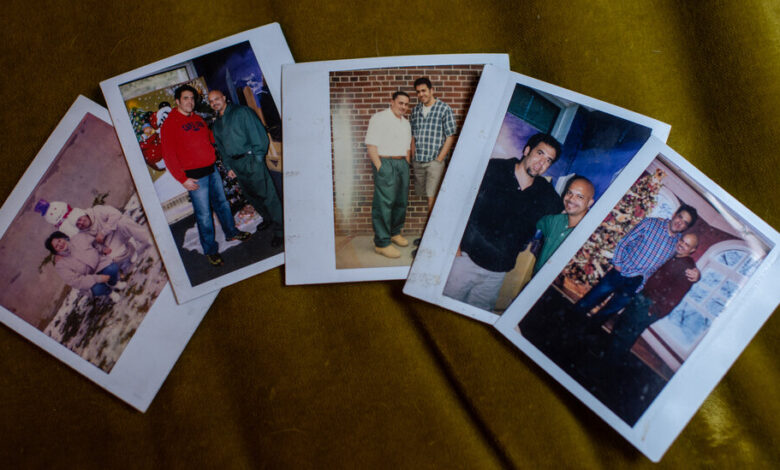Want to Get Out of Prison? Listen to Inmate No. 00A2303.

There were five inmates, all of them sent to prison for murder at the height of New York City’s violent-crime wave in the 1990s. Though their cases were completely unrelated, they all shared a single, fervent belief: Each one knew he had been wrongly convicted.
One inmate in solitary confinement would stuff his ears with torn bedsheets so he could concentrate on drafting his appeals amid the chaos of the other prisoners’ yelling.
Another fixed a broken electric typewriter and muffled it with a pillow so he could type legal correspondence in his cell all night.
Another inmate’s activism and leadership attracted the support of prison administrators and celebrities like Martin Sheen and Alfre Woodard.
Another gained his freedom after a theater volunteer connected him with a newspaper reporter.
And it all started with an offhand comment that a Bronx homicide detective made to a television journalist about a fifth inmate, who was serving time for a murder that another man had committed.
When Dan Slepian, of NBC’s “Dateline,” decided to visit the inmate, it began a chain that would eventually help free these five men. Their tortuous quests for exoneration intersected largely inside Sing Sing Correctional Facility, the notorious maximum-security prison on the Hudson River some 30 miles north of New York City.
“What started with one wrongful conviction claim became a chain of human dominoes,” Mr. Slepian said, “where one innocent person led me to the next.”
The “Dateline” segments, which were broadcast over the span of a dozen years, bolstered each convict’s claims of innocence with new evidence and new witnesses, highlighting problems in how cases were investigated and prosecuted.
The chance of even a single inmate achieving exoneration is a long shot in the New York State prison system, where out of thousands of inmate appeals, only a handful are successful each year. The fact that these five men rallied to support one another is exceptionally rare.
In interviews with The New York Times, the men discussed how they bonded and worked together in prison to overturn the convictions that put them behind bars for a combined century’s worth of time. One after the other, they were released, but they would continue to help those left behind by visiting, donating money, raising awareness and even searching for other possible witnesses.
“Our relationships were reciprocal,” said one of the men, Jon-Adrian Velazquez. “These guys are my brothers.”
The last man out
In September, armed prison guards watched from atop tall concrete walls as a heavy steel door rumbled open to release a middle-aged man holding all of his possessions in a small mesh bag.
It was Jon-Adrian Velazquez, Inmate No. 00A2303, the last of these five to leave prison. He was 46 years old and had served nearly 24 years for a 1998 murder he insists he never committed. After numerous denied appeals, he was finally granted clemency and released.
He hugged his mother and two adult sons, who were little boys when he entered prison as a 22-year-old.
He also hugged Mr. Slepian, who had become a regular visitor over the past two decades.
Now that Mr. Velazquez has been released, Mr. Slepian’s reporting will be developed into a series called “The Sing Sing Chronicles,” to be produced by NBC Studios and directed by the prominent filmmaker Dawn Porter.
“This is a horror story, that innocent people are sent to jail for something they didn’t do,” Ms. Porter said. “These men were supposed to get a fair hearing and a fair legal process.”
The men were all convicted when New York City, facing soaring crime rates, turned to aggressive policing strategies, some of which are being revived today to address the recent rise in violent crime.
Though otherwise unrelated, the five cases shared many of the same troubling traits common in wrongful convictions, including sloppy detective work, questionable legal representation, shaky witness identifications and withheld evidence.
“These five cases check all the boxes of how and why people are wrongfully convicted,” Mr. Slepian said. “But because jury verdicts are seen as sacrosanct, it is exceedingly rare to have a conviction overturned, even when disturbing flaws of a case are revealed.”
The National Registry of Exonerations adds roughly 200 wrongful conviction cases each year to its database but notes that the number of wrongful convictions is unknown and a great majority will probably never be overturned.
Over the past decade, New York City has paid out nearly $500 million in settlements to exonerees seeking compensation for their wrongful convictions.
Remarkably, these five cases did not rely on DNA evidence; not one was overturned by a miraculous lab result. Instead, each required the kind of arduous appeal process that is exceedingly difficult in the best of circumstances. In prison, where these inmates had limited access to phones, meager legal resources and virtually no internet, it was almost impossible.
“Something that could take a day on the outside could take me a month in prison,” said Mr. Velazquez, who was convicted in the 1998 murder of a retired police officer during a botched robbery of a gambling den the officer ran in Harlem.
The case against Mr. Velazquez relied heavily on the testimony of several witnesses who identified him in a lineup as the gunman. But Mr. Slepian’s decade-long investigation for a 2012 “Dateline NBC” segment raised troubling questions. Key eyewitnesses tracked down by Mr. Slepian either expressed doubts about their testimony or recanted entirely.
Despite Mr. Velazquez’s clemency, granted last August by Gov. Andrew M. Cuomo, his conviction remains. He has not been exonerated.
The first domino
Mr. Slepian’s involvement with the five men began in 2002 with a tip from a Bronx homicide detective regarding the high-profile killing of a bouncer outside the Palladium dance club in Manhattan in 1990.
The detective told him that two men — David Lemus and Olmedo Hidalgo — were languishing in prison for the shooting, even though two other men had actually committed the crime.
Mr. Lemus was serving his sentence at the Green Haven Correctional Facility in upstate New York.
Eight years into his 25-years-to-life sentence, Mr. Lemus was studying relevant cases in the Green Haven law library and consulting lawyers on his appeal. His case was gaining momentum with press coverage that included a front-page story in The New York Times in 2000 detailing doubts regarding his conviction.
Mr. Lemus’s dedication impressed Mr. Velazquez, who in 2000 was a new inmate at Green Haven.
“We were just doing time,” Mr. Velazquez said. “But what he showed me gave me hope and showed me it was possible to fight.”
The two inmates bonded in the prison yard, and Mr. Velazquez began to pursue his appeal more actively.
Mr. Lemus also helped Mr. Velazquez land a porter job like the one he had, cleaning and running tasks for inmates. This job provided a degree of freedom to use the law library.
Mr. Slepian’s investigation of Mr. Lemus’s case for a 2005 “Dateline” segment helped uncover new evidence. Several months after the broadcast, Mr. Lemus’s conviction was vacated, and he was released after roughly 15 years in prison.
Before Mr. Lemus left Green Haven, Mr. Velazquez implored him, “Don’t forget me.”
He did not. Mr. Lemus visited Mr. Velazquez regularly, and after receiving a $1.25 million settlement in 2009 for his wrongful conviction, he donated more than $11,000 of it to Mr. Velazquez, enabling him to hire a private investigator for his case, among other expenses.
When Mr. Velazquez was finally released, Mr. Lemus, now 53 and living in Florida, sent him a new iPhone.
A prisoner without a lawyer
But perhaps Mr. Lemus’s greatest gift to Mr. Velazquez had come earlier, in 2002, when he introduced him to Mr. Slepian. This resulted in another “Dateline” segment that raised troubling questions about Mr. Velazquez’s conviction.
Mr. Velazquez resolved to help others seeking exoneration. “Dave passed a blessing to me in Dan, so I vowed to pass the torch forward as much as I could,” said Mr. Velazquez.
In 2005, Mr. Velazquez was transferred to Sing Sing. There, he would introduce Mr. Slepian to three other inmates with compelling wrongful conviction claims.
Sing Sing opened in 1825 and has a notorious reputation; more than 600 executions had been conducted in an adjacent prison building called the Death House, where the electric chair was known as Old Sparky. Its 1,375 inmates include convicted murderers and rapists. But it is also one of the most frequently requested of the state’s 44 prisons, partly because of its proximity to New York City, which makes it easier for many inmates’ families to visit.
Inmates can also earn master’s and bachelor’s degrees through affiliations with nearby colleges, and can take arts classes like jazz guitar, yoga and modern dance.
Once in Sing Sing, Mr. Velazquez took full advantage of the prison programs, becoming a popular leader as he continued work on his case.
But early on, he was an inmate with no lawyer. Prison rules and logistics make legal appeals difficult. Pay phones tend to be outside, in the prison yard, and are often controlled by gangs. Determined to be his “own best advocate,” he set out to prove he was wrongly identified by problematic witnesses.
He pored over legal books and consulted with other inmates in the law library, including a law clerk, Johnny Hincapie, whose infamous murder case was well known among the other inmates.
Jailhouse law 101
Mr. Hincapie was one of seven men convicted in the murder of 22-year-old Brian Watkins, who died trying to defend his parents on a Manhattan subway platform in 1990.
Mr. Watkins and his parents had traveled from Utah to New York to attend the U.S. Open tennis tournament. While waiting for a train, they were surrounded by a group of teenagers demanding their money. One of them fatally stabbed Mr. Watkins.
Though Mr. Hincapie, who was 18 at the time, was not accused of actually stabbing Mr. Watkins, he still faced a murder charge; under state law, any participant in a mugging is held responsible if a victim dies.
Mr. Hincapie, who was arrested the day after the stabbing, claimed he was coerced into signing a confession. Despite his claim that he was not even on the subway platform when the stabbing occurred, he knew his chances were slim of proving his innocence.
Still, within months of his guilty verdict, he began writing letters, longhand, pleading for help from law firms, advocacy groups and foundations that help the wrongfully convicted.
“When you’re in prison, your resources are very, very limited,” Mr. Hincapie said recently. “So you find other cases that have similar attributes to yours, and you contact the attorneys from those cases for guidance.”
Initially, it was hard to find help, so he also began discussing his situation with Mr. Velazquez and with Eric Glisson, who was one of the “Bronx Six,” a group convicted in the murder of a cabdriver in the Bronx in 1995.
Mr. Velazquez took classes with Mr. Glisson, who was serving 25 years to life and seeking to overturn his 1997 conviction, which also was largely based on testimony from a problematic witness — in Mr. Glisson’s case, he was identified through a bathroom window a football field’s length away from the murder location.
Grabbing time in the law library, prison yard and classrooms, the three men began discussing how to file Freedom of Information Act requests and other means to procure documents supporting their claims of innocence.
“Anytime we’d learn something new, we’d discuss it with each other and see if it could work,” Mr. Velazquez said.
A constant backdrop to the legal lessons was navigating Sing Sing, then a brutal environment of violence, gangs and run-ins with correction officers.
“Of course, all the legal stuff is secondary to survival,” said Mr. Glisson. “Self-preservation is first and foremost. You got to always be on point because something is always going down.”
The three inmates caught the eye of Sing Sing’s superintendent, Michael Capra, who styled himself as a tough-but-fair prison warden and promoted educational and rehabilitative programs.
“These guys all had a similar outlook,” Mr. Capra said. “They were positive. They weren’t your average thug, and all of our staff saw something in them.”
Mr. Velazquez would eventually introduce Mr. Slepian to the few fellow inmates whose appeals he believed in. This included Richard Rosario, a tough, brooding man convicted in a 1996 murder in the Bronx.
Mr. Rosario’s bitterness over his wrongful conviction made him a defiant prisoner — not the sort of positive inmate who thrived under the superintendent, Mr. Capra. His behavior had resulted in long stretches of solitary confinement — by his estimate, a total of seven years.
Nonetheless, he was as devoted as the law library regulars, taking his legal materials into solitary with him and plugging his ears with paper and shreds of bedsheet to drown out the ranting from inmates in nearby cells. To call his lawyer, he had to be led to a nearby phone in shackles.
“It’s an uphill battle,” Mr. Rosario said of appealing from prison. “Nothing is structured. You have to learn everything on your own.”
A ‘one-man Innocence Project’
Mr. Velazquez, known as J.J., studied to become a certified paralegal and earned a bachelor’s degree in behavioral science. He also became a teaching fellow, paired with Columbia University teachers, for inmate classes.
His leadership roles, which fostered relationships with other inmates and prison officials, would eventually help his path to freedom.
This included forming a tight relationship with Mr. Slepian, who lived a short drive from Sing Sing. Starting in 2007, the journalist would visit Mr. Velazquez so often that he became well known to the prison administration and gained unusual access.
Soon, inmates from Sing Sing and other prisons, noticing Mr. Slepian’s commitment to Mr. Velazquez, began asking for introductions.
“When J.J. said, ‘I got somebody for you,’ I knew that came after months of vetting a case,” Mr. Slepian said. “For me, here’s an inmate who became a one-man Innocence Project inside Sing Sing.”
Since claims of innocence are so common in prison, even among the guilty, Mr. Slepian said he approached each of the five cases skeptically, maintaining a cautionary presumption of guilt. “But after investigating their cases, I found information and stories that their juries never heard.”
The first one out of Sing Sing
In 2010, Mr. Slepian was in Sing Sing to produce a segment on Mr. Velazquez. His film crew had been given access to Honor Block, the living quarters for inmates with good disciplinary records. It was there that Mr. Velazquez introduced the producer to Johnny Hincapie.
When he was arrested, Mr. Hincapie was a slight, college-bound teenager from Bayside, Queens, who was DJing in nightclubs.
It was a fraught moment in the city. There were more than 2,200 murders in 1990. The subway stabbing inspired fear and anger in New York and was seen as a tipping point. The case was handled by some of the same detectives, using some of the same aggressive policing strategies, as the infamous Central Park jogger rape case the year before.
Mr. Hincapie said he was beaten and coerced into making a false confession by a detective who convinced him that admitting a minor role in the robbery would allow him to go home and receive lenient punishment. But he was convicted of murder and sentenced to 25 years to life in prison.
Mr. Hincapie tried to make the best of it. While they worked on their cases, he and Mr. Glisson enrolled in the prison’s theater program. They acted together in productions like “Twelve Angry Men” and “West Side Story.”
Just when Mr. Hincapie had exhausted his appeals, his theater coach, Kim Breden, helped connect him with a newspaper reporter, Bill Hughes, who wrote an article that revealed new witnesses. They ended up testifying that he had not been near the subway stabbing.
Mr. Hincapie’s conviction was vacated by a judge in 2015 after he had spent 25 years in prison, and prosecutors finally dropped his case in 2017. He is 49 and lives in Florida.
‘I might die in prison’
For Mr. Glisson, the theater program provided respite from the frustrations of his appeal, which included writing hundreds of letters and perhaps 80 Freedom of Information requests. He searched tirelessly to find exonerating witness information withheld from his trial.
“I just kept trying — I was going to die on my feet, not on my knees,” said Mr. Glisson, who entered prison as a teenager with only a fifth-grade education.
Inside, he studied to be a paralegal in order to appeal his conviction and also earned a bachelor’s degree.
His 6-by-8 cell, where he kept a “wall of hope” covered with articles about exonerated inmates, served as a repair shop where he fixed inmates’ radios, hot plates and other items in exchange for their allotment of stamps and envelopes, which he would use for legal correspondence.
After fixing a microwave oven for some correction officers, he was given a broken electric typewriter. Mr. Glisson repaired that, too, and spent his nights typing his legal appeals, muffling the typewriter with a pillow to avoid waking other inmates.
But by 2006, after 11 years in prison, he was notified that he had exhausted his last appeal.
It was at a rehearsal for “Macbeth” that the gravity of the situation set in. “I just broke down,” Mr. Glisson recalled, “realizing I might die in prison.”
But a volunteer with the program — Sister Joanna Chan, a nun known to the inmates as Grandma — noticed his despair and cryptically told him it was crucial to summon his best performance. After the show, she introduced him to Peter Cross, a Manhattan lawyer who had attended the play. He agreed to take on Mr. Glisson’s case pro bono and made crucial advances.
But it was Mr. Glisson himself who found the real murderer. In 2012, one of his Freedom of Information requests yielded suppressed documents showing that two gang members had used the cellphone of the Bronx cabdriver he had supposedly killed.
Mr. Glisson included this new information in a letter to federal prosecutors that happened to land on the desk of a federal investigator, John O’Malley.
Through another case, Mr. O’Malley knew that another man had confessed to killing a livery driver, information that would become crucial to Mr. Glisson’s exoneration.
But with that exoneration still delayed, Mr. Velazquez introduced Mr. Glisson to Mr. Slepian. A WNBC news segment aired in August 2012, after which Mr. Glisson, his conviction dismissed by a judge, was released at age 35 after serving nearly 18 years.
‘I have another one for you’
Even as his own appeals met denial after denial, Mr. Velazquez sat across from Mr. Slepian in a Sing Sing visiting room in late 2012 and told him, “I have another one for you.”
This was Richard Rosario, who was convicted on questionable witness testimony, despite providing the authorities with 13 alibi witnesses to confirm he had been in Florida when the murder was committed in the Bronx.
Neither the authorities nor his own lawyers ever went to Florida to interview them, and the issue of ineffective legal representation loomed so large in his case that it would eventually be considered for review by the U.S. Supreme Court.
From 1998 until his release in 2016, Mr. Rosario sent hundreds of handwritten letters to lawyers, advocates and other authorities, seeking evidence that witnesses had wrongly identified him at trial. He began to receive police reports with redacted sections that hinted at problems with witnesses.
Mr. Slepian did travel to Florida to interview most of the 13 alibi witnesses, who included a deputy sheriff, a pastor and a federal correction officer.
It resulted in a 2016 “Dateline” series. That same month, Mr. Rosario’s conviction was vacated by the Bronx district attorney and he was released from Sing Sing.
When Mr. Rosario finally walked free out of a Bronx courtroom, he faced news cameras and said, “Free Jon-Adrian Velazquez.”
A fateful cell visit
As each of the other four inmates gained their freedom, reunited with their families and starting to pursue compensation settlements, Mr. Velazquez posted newspaper clippings about their releases on the walls of his cell.
“I wasn’t bitter about other guys being released,” he said. “In fact, I celebrated that.”
Each of the four returned to visit him in Sing Sing and supported his appeal. Mr. Glisson and Mr. Lemus sent him money to hire investigators.
Mr. Velazquez’s case drew support from celebrities who visited him in prison, including Martin Sheen, who visited twice. Also supportive were the actress Alfre Woodard, and the music industry executive Jason Flom, who visited him frequently.
Mr. Velazquez had forged a unique rapport with the prison’s administration, especially Mr. Capra, the superintendent, who wrote a letter supporting Mr. Velazquez’s application for clemency from the governor.
One day last August, the cellblock went silent as Mr. Capra showed up at Mr. Velazquez’s cell. He was holding a letter.
Mr. Velazquez had been granted clemency and was going home.
In a rare emotional moment for the by-the-books warden, he hugged Mr. Velazquez as the entire cellblock broke into shouts and applause.
Mr. Velazquez, who is still on parole, now works for the Frederick Douglass Project for Justice, organizing prison visitation programs for civilians.
His is one of the first cases up for review by the post-conviction justice unit newly formed by Alvin Bragg, the new district attorney for Manhattan.
This past Monday, Mr. Velazquez was back at Sing Sing, meeting with Mr. Capra about creating a program for inmates.
“I made a promise to the men that I’d be back to help them,” he said. “I need to help the people I left behind.”




